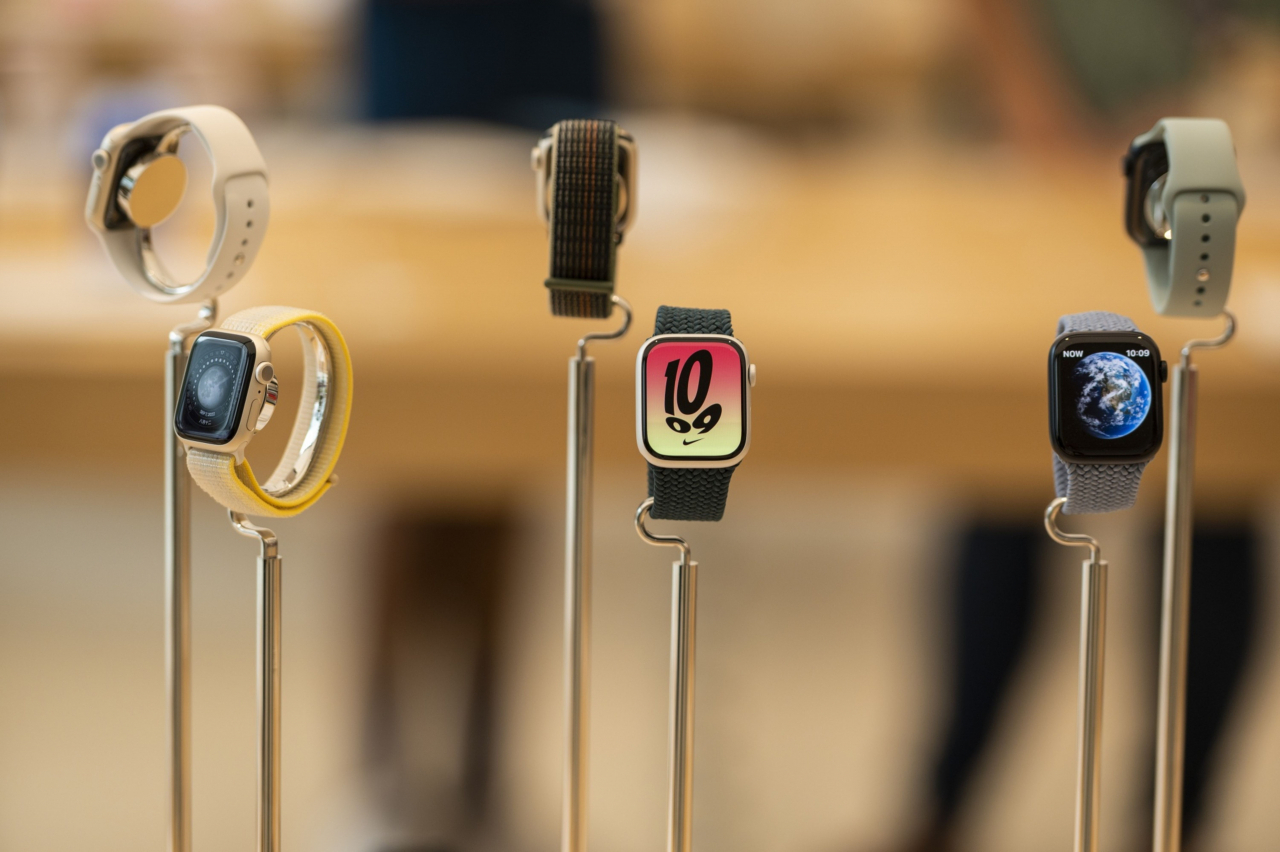Market Now
[KH explains] Apple’s move to ditch Korean displays met with skepticism
 |
Apple Watches are on display at Apple's flagship store in Singapore. (Bloomberg) |
Having announced its plans to make more chips on its own, Apple, the world’s largest consumer electronics company by revenue, is now reportedly seeking to use its own displays whose supplies are heavily reliant on South Korea’s Samsung and LG.
Bloomberg reported Wednesday that Apple is planning to start using its own micro light-emitting diode displays on its smartwatches as early as the end of 2024, possibly with the aim to reduce its reliance on Korea-made displays.
Citing unnamed sources, the media outlet said Apple would be replacing the current organic light-emitting diode screens with its own in-house micro light-emitting diode displays. The first batches will likely be tested on the high-end models of its Apple Watches.
The news report immediately prompted speculation in Korea that the move could deal a severe blow to Samsung and LG, whose key clients include the iPhone maker.
When it comes to the latest iPhone 14, Samsung and LG are estimated to supply 70 percent and 20 percent of the OLED displays. For the Apple Watches, LG is known to be supplying almost 80 percent of the panels.
Both Samsung and LG declined to comment on their partnership with Apple as well as the client’s possible ditching their panels.
With the two companies remaining mum, industry watchers here were skeptical of serious impacts from the latest development, citing the highly sophisticated production of microLEDs that are still in their nascent stage.
“Making its own displays is a totally different story from making its own chips,” Yi Choong-hoon, CEO and top analyst of Seoul-based display market tracker UBI Research, told The Korea Herald referring to how Apple had recently decided to ditch Intel to use its own chip designs on its laptops and desktops.
“The yield management for microLEDs is still extremely immature and unstable. Even if Apple does come up with its own microLED screens, it will be hard to completely commercialize the technology in such a short time,” he said.
He predicted little impact on the current suppliers, saying it would be difficult for Apple to end its existing ties so abruptly.
Another source said, however, that Apple’s ending of the long-held partnership with its Korean suppliers, especially its archrival Samsung, is nothing unexpected. According to market tracker Counterpoint, Samsung topped global smartphone shipments in the fourth quarter last year with a 21 percent market share, followed by Apple at 16.1 percent.
“Apple and Samsung compete head-on globally. Apple has always been cautious about sharing classified business information with Samsung-affiliated suppliers,” the source said on condition of anonymity. More recently, Samsung is putting resources to strengthen its unrivaled leadership in foldable phone markets, while Apple is rumored to be working on its own version set to be launched in 2024.
According to Bloomberg, LG Display relies on 36 percent of its revenue coming from Apple, while Samsung has about 6.6 percent of its sales from the iPhone maker. Following Wednesday's report, LG Display shares fell as much as 4.1 percent.
In the meantime, Apple is expected to find a production partner even when it completes the microLED technology because it doesn’t own production facilities.
"Because Apple does not have their own production facilities, they would have to rely on other companies for the actual production of the microLED screens," said an industry official who wished to be unnamed.
“Currently, Samsung and LG are the leading producers of the tricky OLEDs in the market. For the trickier microLED, it would be difficult to find the right partner among some Chinese or Japanese display makers other than the two.”
Recent reports speculate that Apple may work with Chinese display maker BOE Technology on its production of microLED.
BOE is planning to invest about $400 million to build two factories in Vietnam, Reuters reported earlier. While the facilities are designed to mainly produce OLED panels, the report said, some production lines could be dedicated to microLED for Apple.
By Jo He-rim (herim@heraldcorp.com)








